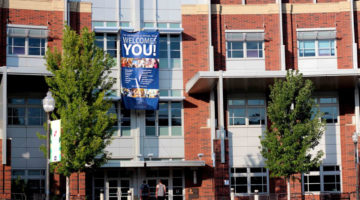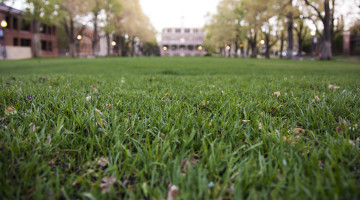
This photo was taken by Alberto Garcia for an art project that was meant to commemorate the final days of White Pine Hall.
By Daniel Lang
Editor’s note: This story is a follow up to the Dec. 8 story “Losing a Home,” which detailed the unique community that came out of student housing at White Pine Hall. This new story serves to give all the details surrounding the hall’s situation, from its initial closing to its upcoming demolition within two weeks.
Driving down Virginia Street, one notices three residence halls — just 12 months ago, they hummed with student life — today they see only construction workers.
Of Lincoln, White Pine and Manzanita Halls, only the latter sees silence nowadays. Yet just last summer, Manzanita was still meant to hold students.
Less than a week before move-in for the fall 2015 semester, incoming freshmen and Residential Life, Housing, and Food Service were startled to learn that a residence hall reopened would remain closed and that a hall closed would reopen.
Confused? News of the Manzanita Hall re-closure came from a story published by the Reno Gazette-Journal on Aug. 14, 2015. As previously reported by The Sagebrush, the 70 incoming students to Manzanita Hall, mostly freshmen, found themselves sent to live in White Pine for the better part of a semester. The residence hall, now shrouded, prepares for demolition.
Last summer, the university reported that Manzanita, Lincoln and White Pine residence halls would no longer be used to house students after the spring semester.
It came as a surprise, then, that Manzanita Hall was reopened to students for the fall semester.
“We knew we were looking at a scenario where we were getting into an overflow capacity,” Rod Aeshlimann, director of RLHFS, explained. According to a university press release, the system had reached 120 percent capacity.
The department heard that while plans for Lincoln’s renovation had begun, work on Manzanita had not started, Aeshlimann said.
“We suggested that we continue to use either one of those buildings [Lincoln or Manzanita Hall], knowing that White Pine would delay construction for conceivably a year,” said Aeshlimann. Manzanita was approved.
How It Came to This
Manzanita and Lincoln halls were two of many buildings on campus designated by Nevada Public Works as “unreinforced masonry.” This lack of reinforcement means the buildings are not safe from earthquakes.
The university discussed the possibility of reinforcing the two historic buildings so they might continue to house residents, explained Gerald Marczynski, dean of students and associate vice president of Student Life Services. But the price was simply too high. Without direct funding available for such drastic renovations, students’ housing rates would have risen significantly.
“It would have almost been three times what it would have cost to build it [Manzanita] new,” Marczynski said. “We just can’t do that.”
Great Basin, the 130,000-square-foot residence hall set to open in August 2017, is costing the university $57 million to build, according to the Reno Gazette-Journal. It is paid for by residence hall fees and bonds. However, the costs are $50 million less to renovate Lincoln. The $7.13 million project, turned over from the housing department to the university, is being covered by institutional funds.
With tuition costs already climbing, students and staff alike preferred not to aggravate a growing pain. So instead of housing new residents, the Manzanita and Lincoln Halls would instead be preserved for faculty offices. Renovations for Lincoln are underway.
However, NPW said nothing about Manzanita Hall — the university had not reported its plans. According to Marczynski, the state board was under the impression that Manzanita followed a similar plan to vacate, like Lincoln. But without any direct reports that the buildings were unsafe, the university took the board’s silence on Manzanita as a go-ahead.
The series of miscommunications climaxed at summer’s end with the story that Manzanita Hall would close after all.
Where White Pine Comes In
Unlike Manzanita and Lincoln, White Pine Hall was not listed in the National Register of Historic Places that protected those oldest buildings. Therefore, explained Marczynski, the Board of Regents had been in talks for the last six years about using the location as a building site for a new, larger hall. Indeed, while White Pine housed an estimated 120 beds, its successor, Great Basin Hall, will house 430.
For reasons unknown to the housing department, White Pine Hall’s demolition has not yet begun as planned by the latter part of summer. Incoming students bound for Manzanita had a place to live, if only for a short time. As representatives from the department later explained, enough students would be expected to drop from the housing system over the course of the semester that White Pine’s temporary residents could be moved elsewhere at a later date.
In regard to postponing demolition, the housing department faced a number of issues. Aeshlimann cited escalation costs the RLHFS could not cover. Marczynski cited the problem of construction setbacks. With Great Basin’s construction estimated to take 18 months, the residence hall would face significantly less use if it were to open during a spring semester.
As Aeshlimann further explained, the new hall will be unable to fund itself anyway.
Regarding the Nevada Living Learning Community, Aeshlimann said, “At full occupancy, 110 percent of the revenue goes to bonds. That’s no staffing. That’s no utilities. That’s no heat. That’s no wear-and-tear. That’s nothing.”
When the next hall opens, it needs to maximize revenue generation — and that means Great Basin’s construction starting in the spring.
So could the debacle of residents and halls have been avoided? Perhaps.
But when construction began on Peavine Hall in March 2014, RLHFS did not foresee losing White Pine, Lincoln and Manzanita all at once.
“We could’ve built, for instance, a larger high-rise building on that site; it would’ve fit-in with some of the other structures around it, including Argenta,” Aeshlimann said. “Unfortunately, by the time we learned the Lincoln, Manzanita decisions, then it was too late to make changes.”
The Residents of White Pine
In that single fall semester that the residents of White Pine had to live there, they made the most of their time.
“The stuff that really sticks in your memory is just meeting different residents and seeing them kinda make this wonderfully ugly building home,” said Aimee Kelly, a desk attendant who worked in White Pine during the semester. “I just think of all the people that I talked to and all the stories you get to see a part of.”
Their experiences were recorded through a student-driven outreach project called “Humans of White Pine,” endorsed by the hall’s short-lived leadership council.
According to Marczynski, the housing department offered compensation to the students forced to move that semester.
“We’re gonna assist them in moving to new facilities,” Marczynski said. In addition, he said reasonable housing rates were charged.
In terms of rates, the housing website detailed that White Pine Hall residents were charged costs identical to Argenta Hall Triples, Nye Hall Doubles, Peavine Hall Triples, Juniper Hall Doubles and Sierra Hall Double/Triples. When asked, few residents could answer definitively whether they felt financial compensation outweighed added stress.
For one reason or another, the move-out was not as smooth as residents or RLHFS had hoped for, either. Of over two dozen former residents independently surveyed by The Sagebrush, only two reported having been assisted by personnel from the housing department.
More students reported unfavorable experiences. Students including Liz Delikat, Ashley Huston, Kristina Ilagan, Kait McDaniel, Brooke Miller, Fuka Nagase and Isabel Villanueva all reported taxing ordeals. On more than one occasion, students were saddled with small timeframes to move, sometimes having less than 24 hours. Some had been so upset by their experience, they declined to comment after having left the hall.
“It was a very stressful process which we would appreciate to have to never go through ever again,” Delikat said.
More than one student expressed such distaste with their experience — whether having to adjust with new roommates they had no choice in or dealing with staff members they claimed had underperformed — that they chose to violate their housing license agreement, which binds students for “a full academic year,” and move off campus.
By Dec. 18, 2015, all furniture was removed from White Pine Hall. Asbestos abatement began over winter break. As of late January 2016, Aeshlimann says demolition will take place in the next two weeks.
Following the end of White Pine, construction on Great Basin will begin as planned.
Daniel Lang can be reached at jsolis@sagebrush.unr.edu and on Twitter @MemoryLang.











